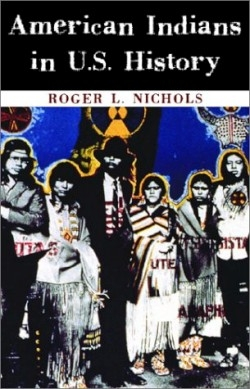American Indians in U.S. History
“When we first had this land we were strong,” Lakota Chief Red Cloud told federal officials in Washington in 1870, as he described the changes in the lives of the Sioux since the advent of Western settlers and the subsequent attempts to move his people onto reservations. “Now,” said Red Cloud, “we are melting like snow on the hillside.”
That is the unfortunate reality that the author presents. Nichols is a professor of history at the University of Arizona and the author of several other books on Indians and the American West, tracing the history of Indians in America from their earliest beginnings up to current events.
Designed as a general overview, the book moves both chronologically and demographically, beginning with the Indians’ first sightings of the Spanish, French, and English explorers and invaders, circa 1500: “Some had fur on their faces and looked like dogs, others gazed out through eyes the color of the sky, while a few had hair the color of sand or dried grass.”
Nichols writes that whether or not the Indians realized it, these invasions by various European groups would change their lives forever. Disease took its toll as entire villages sickened and died. Attacks and skirmishes followed. It was a pattern for the next three hundred years; some tribes moved further westward in an attempt to escape the continuous flow of settlers.
The early colonial powers tried to acculturate the natives; this was the purposeful changing of one society by contact with another. Europeans used religion and education to ingratiate themselves. For example, the 1693 charter for the College of William and Mary in Virginia called for the new school to educate some of the nearby villagers. The United States government would continue its policy of trying to assimilate the Native Americans well into the twentieth century.
Nichols points out that inter-tribal conflicts also left tribes vulnerable. Broken treaties and forced re-settlements were the eventual results 500 years after the first white men stepped foot in North America.
Because this is just a brief survey of the topic, the author provides a list of suggested further readings on topics presented within each chapter. It’s a nice addendum for those wanting to pursue a specific subject in more detail.
In 1988, Congress passed the Indian Gaming Regulatory Act; within less than a decade over 100 tribes throughout the country had opened up some kind of gambling facility. In a nice twist of irony, Indian leaders refer to this popular pastime as “the new buffalo” for their people.
Disclosure: This article is not an endorsement, but a review. The publisher of this book provided free copies of the book to have their book reviewed by a professional reviewer. No fee was paid by the publisher for this review. Foreword Reviews only recommends books that we love. Foreword Magazine, Inc. is disclosing this in accordance with the Federal Trade Commission’s 16 CFR, Part 255.

